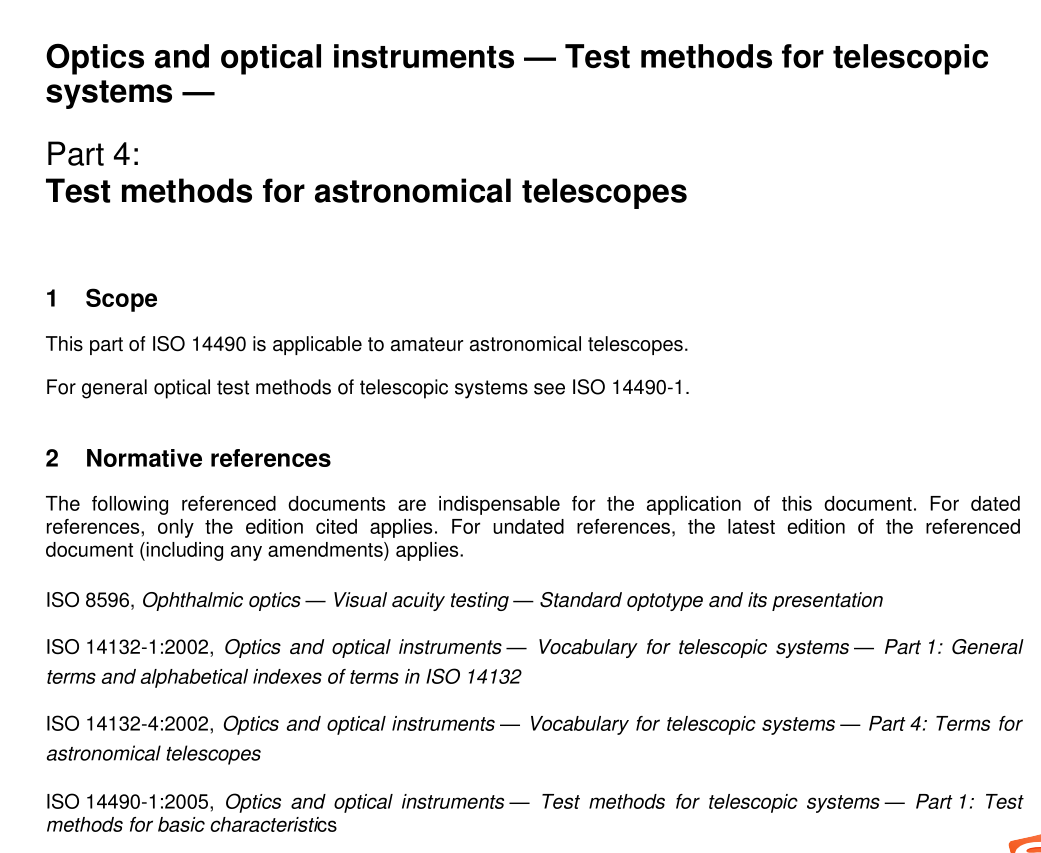BS ISO 14490-4 pdf download

BS ISO 14490-4 pdf download Optics and optical instruments — Test methods for telescopic systems — Part 4: Test methods for astronomical telescopes
1Scope
This part of lSO 14490 is applicable to amateur astronomical telescopes.For general optical test methods of telescopic systems see lSO 14490-1.
2Normative references
The following referenced documents are indispensable for the application of this document.For datedreferences,only the edition cited applies. For undated references,the latest edition of the referenceddocument (including any amendments) applies.
ISO 8596,Ophthalmic optics — Visual acuity testing — Standard optotype and its presentation
ISO14132-1:2002, Optics and optical instruments — Vocabulary for telescopic systems — Part 1: Generalterms and alphabetical indexes of terms in lSO 14132
ISO 14132-4:2002,Optics and optical instruments — Vocabulary for telescopic systems — Part 4 :Terms forastronomical telescopes
ISO 14490-1:2005,Optics and optical instruments — Test methods for telescopic systems — Part 1:Testmethods for basic characteristics
3Terms and definitions
For the purposes of this document, the terms and definitions given in ISO 14132-1 and ISO 14132-4 apply.
4optical test methods for astronomical telescopes
Typical test methods are shown here, and other similar methods are acceptable.4.1Clear aperture of objective
The clear aperture of the objective shall be measured by one of the following methods.
a) Measure the unobstructed diameter of the objective lens of refracting telescopes and finder telescopes or
that of the main mirror of reflecting telescopes by means of an appropriate linear measuring instrument.b) Set the focus of the optical system of the telescope or finder telescope to infinity using a dioptric tester.
Set a bundle of parallel rays at zero incidence angle using a collimator on the eyepiece side, project theexit bundle of rays from the objective onto a screen perpendicular to the optical axis and measure itsdiameter.
c)Using a piece of ground glass let diffuse light be incident on the eyepiece side of the telescope or the
finder telescope, and measure the minimum value of the aperture of the objective by using a travellingmicroscope parallel to the optical axis in object space,which can be moved across the diameter of theobjective.
4.2Focal lengths of objective and eyepiece
The test methods for the focal lengths of objective and eyepiece shall be as given in 4.2.1 or 4.2.2.
4.2.1 Focal length of objective lens and eyepiece (nodal slide method)
Refer to Figure 1. Arrange the rotary table (item 8 in Figure 1)(nodal slide stand), so that the axis of rotation isperpendicular to the optical axis of the collimator lens (item 3) on an optical bench (item 6). Place a reticle(item 2) at the focal plane of the collimator. On the rotary table, a slide stand (item 7) is moving in the directionof the optical axis of the microscope (item 5), which has its optical axis approximately coinciding with that ofthe collimator. Measure the focal length f in accordance with 4.2.1.1 to 4.2.1.3.
4.2.1.1 Install the alignment reticle (item 4 in Figure 1) on the slide stand (item 7) so that the alignmentreticle (item 4) coincides with the axis of the rotation of the rotary table (item 8), as shown in Figure 1 a).Whileadjusting the microscope (item 5) so that the reticle (item 4) can be seen clearly, read out the position of themicroscope on the optical bench (item 6) and stop when the position of the reticle (item 4) is such that, when itis slightly rotated about its vertical axis, there is no lateral movement of the image.
4.2.1.2 Remove the alignment reticle (item 4) and mount the objective lens (item 9) under test on theslide stand (item 7) in front of the collimator. Adjust the microscope (item 5) until the sharp image of thecollimator reticle (item 2) formed by the lens under test can be seen clearly. Set the rear nodal plane of thelens under test to coincide with the axis of rotation of the rotary table (item 8), as shown in Figure 1 b), i.e.when the rotary table is slightly rotated about its vertical axis, the image of the collimator reticle is stationary.Read out the new position of the microscope on the optical bench.
4.2.1.3 The equivalent focal length f of the objective lens to be measured is the difference between thepositions of the microscope in 4.2.1.1 and 4.2.1.2.









